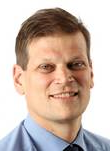 |
|
||||
BiographyTibor Grasser is a professor of microelectronics reliability and an IEEE Fellow. He has been the head of the Institute for Microelectronics since 2016. He has edited various books, e.g. on advanced device modeling (World Scientific), the bias temperature instability (Springer) and hot carrier degradation (Springer), is a distinguished lecturer of the IEEE EDS, is a recipient of the Best and Outstanding Paper Awards at IRPS (2008, 2010, 2012, and 2014), IPFA (2013 and 2014), ESREF (2008) and the IEEE EDS Paul Rappaport Award (2011). He currently serves as an Associate Editor for the IEEE Transactions on Electron Devices following his assignment as Associate Editor for Microelectronics Reliability (Elsevier) and has been involved in various outstanding conferences such as IEDM, IRPS, SISPAD, ESSDERC, and IIRW. Prof. Grasser's current research interests include theoretical modeling of performance aspects of 2D and 3D devices (charge trapping, reliability), starting from the ab initio level over more efficient quantum-mechanical descriptions up to TCAD modeling. The models developed in his group have been made available in the most important commercial TCAD environments.
|
|||||
Preface
Welcome to the 33rd Annual Research Review of the Institute for Microelectronics!
Our permanent staff members, financed by the Austrian Federal Ministry of Education, Science and Research, have changed from last year and consist of eight full-time and four part-time employees: five professors, two assistant professors, two senior scientists, a secretary, and one part-time and two full-time technical assistants. In addition, one federally funded post-doctoral researcher and five doctoral researchers are working on exciting research problems. Furthermore, twenty-one scientists and twelve post-doctoral researchers are presently funded through projects supported by our industrial partners, the Austrian Science Fund (FWF), the Austrian Research Promotion Agency (FFG), the Christian Doppler Gesellschaft (CDG) and the European Commission (EU).
Over the last year, two Austrian Science Fund funded projects (“Reliability of Transition Metal Dichalcogenide Field Effect Transistors” and “Wigner State Control for Entangled Electronics”) and one Austrian Research Promotion Agency project (“Innovative Communication Electronics for Aircraft Engines”) have been successfully completed. The CDG projects on “High Performance Technology CAD”, “Nonvolatile Magnetoresistive Memory and Logic” and “Single-Defect Spectroscopy in Semiconductor Devices”, as well as three projects funded by the FWF and the two FFG projects, “Innovative Networks for Networked Aircraft Subsystems” and “Technology Computer Aided Design of Negative Capacitance and Ferro-Electric Transistors”, are proceeding according to plan. We are very pleased that our industrial partners have continued and extended their support for projects addressing a wide array of topics, such as reliability at cryogenic temperatures, the potential and risks of pilot technologies for power semiconductors in regards to reliability, manufacturing and application, efficient quantum transport modeling for TCAD applications, advanced MOSFET reliability characterization using array structures, modeling of hot-carrier degradation in Si-transistors, and quantum mechanical simulation of tandem solar cells to study the influence of technological parameters on efficiency.
It is a great pleasure for us to report that two directly funded projects, namely “Device Degradation and Recovery for Circuit Simulation” and “Defect Spectroscopy of Integrated Photo Diodes”, three FFG projects, “Nanoelectronic Device Simulation”, “Innovative, Civil UAV Control Platform ReLoaded” and “Process-Aware Structure Emulation for Device-Technology Co-Optimization”, as well as one H2020 project, “Modeling Unconventional Nanoscaled Device FABrication”, and two FWF projects, “General Nano-Electromagnetic Quantum Phase Space Model” and “Numerical Constraints for the Wigner and the Sigma Equation”, were started during the past year.
We are exceptionally proud of our Institute's consistently high academic and scientific output. This is reflected in our large number of long-term projects and in our high number of publications, especially when it comes to contributing to and participating in leading international conferences. We are aware, however, that this success would not be possible without the continuous support of our collaborators within academia and industry. We would therefore explicitly like to express our gratitude for their trust in our scientific work. In this regard, we are entering into the next year of our Institute, as ever, with high expectations.


